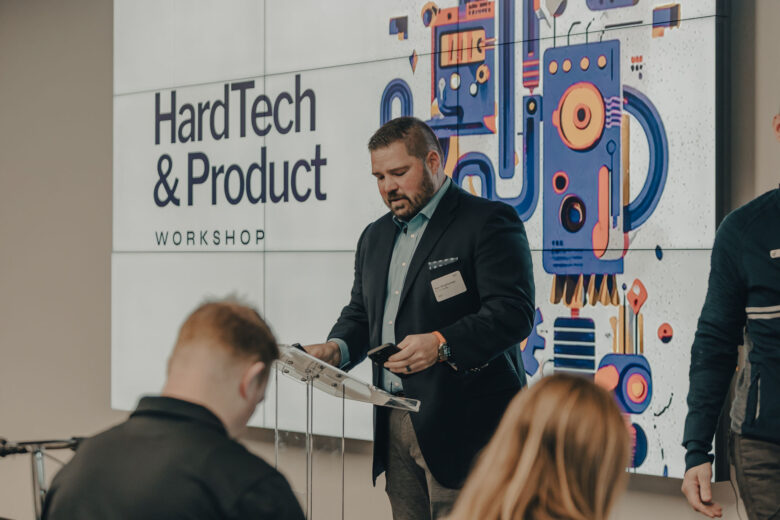Blog
HardTech Manufacturing and Supply Chain
- Blog,
Indiana has always been a state that knows how to build. Hardtech founders here are not only designing products, they are bringing them to life in real factories with real supply chains. Elevate Ventures continues to invest in this work because it creates durable companies, quality jobs, and technology that can compete globally. In this session, Ben Wrightsman, founder of XC Technology, brought more than 30 years of experience in electronics, contract manufacturing, and hardtech to walk founders through what it actually takes to move from a single prototype to a reliable and scalable product.
He opened with a candid observation. Hardtech is not for the faint of heart. It operates at the speed of physics and materials, not at the speed of code. That reality creates longer development cycles, higher upfront costs, and far more variables to manage. His goal was not to discourage founders, but to give them a realistic blueprint to reduce risk, use supply chain as a strategic differentiator, and avoid the many valleys of death that exist between idea and scale.
Session Overview
Wrightsman began by redefining what people mean when they say tech. Most people think about apps, software and digital products that can be updated overnight. Hardtech is different. It is about things you can touch, see and assemble. It is about atoms, not only bits. These products power energy systems, mobility, aerospace, medical devices and connected infrastructure. Because they live in the real world they must survive real world economics, compliance and logistics.
He explained why hardtech is hard. Development is long. It is common for products to take years to reach meaningful production. Upfront investment is heavy. Even large companies underestimate how much capital it will take to reach market. Integration is complex. Hardware, software and manufacturing must work together. And scaling is linear. Unlike software, you cannot instantly serve a million users. To double output you often have to double people, space, inventory and suppliers.
From there, he laid out a four part blueprint that founders can act on today. Document everything. Design for manufacturing and assembly. Make smart decisions about what to build in house and what to outsource. And build a resilient hybrid supply chain that uses both local and global partners. Throughout the talk he emphasized that supply chain is not a back office function. It can be a competitive advantage when treated as strategic.
Key Takeaways
- Document early and thoroughly. Product requirements, bills of material, critical quality parameters and market feedback should be written down before you approach outside partners. Documentation is your destiny.
- Design for manufacturing and assembly as you prototype. DFM and DFA are not separate steps. They should run in parallel with product development so you do not discover later that your product cannot be built affordably.
- Bring manufacturing expertise in early. Contract manufacturers and design firms can tell you quickly if your idea can be produced at scale. Use them to validate and to avoid expensive rework.
- Be intentional about insourcing and outsourcing. Keep core IP, secret processes and critical formulations in house. Outsource standard processes, high volume work and anything that would require large capital investments.
- Use contract manufacturing to extend your team. Good CMs already have supplier networks, qualified processes and capacity. Let them build so your team can focus on product and customers.
- Build a hybrid supply chain. Source locally for critical, short lead, IP heavy parts. Source globally for volume, cost efficiency and access to innovation. Do not rely on one region.
- De risk with dual sourcing and buffer stock. Identify the components that can shut your business down and line up at least two suppliers. Keep inventory on hand for those items even if it feels expensive.
- Relationships matter. Strategic, transparent relationships with suppliers, design houses and manufacturing partners are real advantages. Treat them as partners, not vendors.
Why It Matters
Wrightsman reminded the room that market volatility, geopolitical tension and compliance changes are not new. They have always been part of building products. Waiting for the market to stabilize is not a strategy. Instead founders should build products and supply chains that can flex. Indiana is well positioned for this because it has both local manufacturing strength and access to global networks.
For Elevate Ventures, these are the companies worth backing. Teams that document, design for production, take supply chain seriously, and partner well are the ones that make it through the valleys of death. They are also the ones that can attract future capital because investors see discipline and readiness.
Presentation Slides
- Explore Ben Wrightman’’s full presentation deck from this session:
Closing Reflection
Wrightsman closed with a simple charge. Prioritize relationships. Define and document your product. Design a flexible supply chain. And do not try to build everything yourself. The hard in hardtech is real, but so is the opportunity for founders who plan ahead and use Indiana’s ecosystem to their advantage.




Explore the HardTech & Product Workshop Photo Gallery
Featured News
-
HardTech & Product Workshop: Indiana’s Innovators Are Building What’s Next
Read More -
Independent Audit Clears Elevate Ventures
Read More -
20 Episodes In: A Trip Down Memory Lane with Innovate or Evaporate
Read More -
Fireside Chat — Corporate Partnerships and Strategic M&A
Read More -
Funding the Stages of a Hardtech Company
Read More -
Getting HardTech Prototypes to V1
Read More